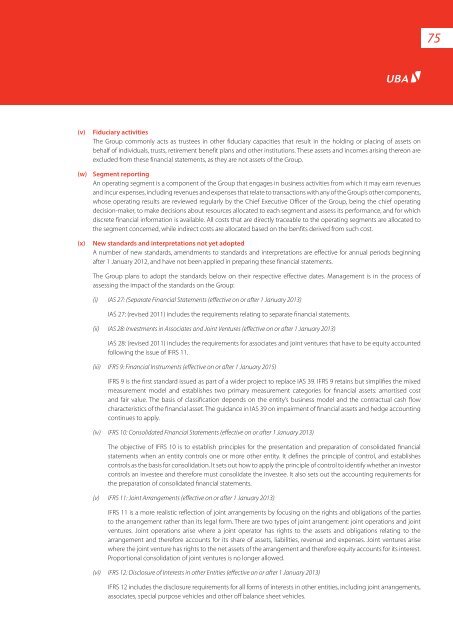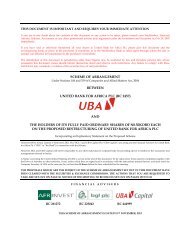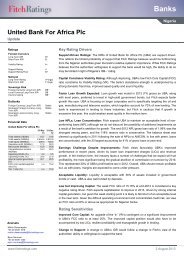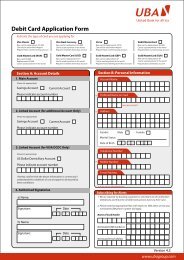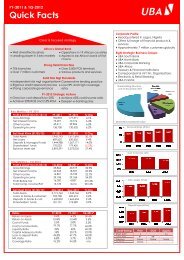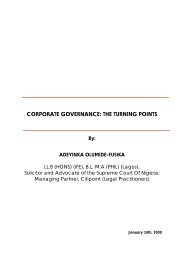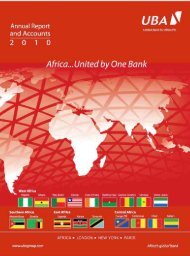2012 Annual Report & Financial Statements - UBA Plc
2012 Annual Report & Financial Statements - UBA Plc
2012 Annual Report & Financial Statements - UBA Plc
Create successful ePaper yourself
Turn your PDF publications into a flip-book with our unique Google optimized e-Paper software.
75<br />
(v)<br />
(w)<br />
(x)<br />
Fiduciary activities<br />
The Group commonly acts as trustees in other fiduciary capacities that result in the holding or placing of assets on<br />
behalf of individuals, trusts, retirement benefit plans and other institutions. These assets and incomes arising thereon are<br />
excluded from these financial statements, as they are not assets of the Group.<br />
Segment reporting<br />
An operating segment is a component of the Group that engages in business activities from which it may earn revenues<br />
and incur expenses, including revenues and expenses that relate to transactions with any of the Group’s other components,<br />
whose operating results are reviewed regularly by the Chief Executive Officer of the Group, being the chief operating<br />
decision-maker, to make decisions about resources allocated to each segment and assess its performance, and for which<br />
discrete financial information is available. All costs that are directly traceable to the operating segments are allocated to<br />
the segment concerned, while indirect costs are allocated based on the benfits derived from such cost.<br />
New standards and interpretations not yet adopted<br />
A number of new standards, amendments to standards and interpretations are effective for annual periods beginning<br />
after 1 January <strong>2012</strong>, and have not been applied in preparing these financial statements.<br />
The Group plans to adopt the standards below on their respective effective dates. Management is in the process of<br />
assessing the impact of the standards on the Group:<br />
(i) IAS 27: (Separate <strong>Financial</strong> <strong>Statements</strong> (effective on or after 1 January 2013)<br />
IAS 27: (revised 2011) includes the requirements relating to separate financial statements.<br />
(ii) IAS 28: Investments in Associates and Joint Ventures (effective on or after 1 January 2013)<br />
IAS 28: (revised 2011) includes the requirements for associates and joint ventures that have to be equity accounted<br />
following the issue of IFRS 11.<br />
(iii) IFRS 9: <strong>Financial</strong> Instruments (effective on or after 1 January 2015)<br />
IFRS 9 is the first standard issued as part of a wider project to replace IAS 39. IFRS 9 retains but simplifies the mixed<br />
measurement model and establishes two primary measurement categories for financial assets: amortised cost<br />
and fair value. The basis of classification depends on the entity’s business model and the contractual cash flow<br />
characteristics of the financial asset. The guidance in IAS 39 on impairment of financial assets and hedge accounting<br />
continues to apply.<br />
(iv) IFRS 10: Consolidated <strong>Financial</strong> <strong>Statements</strong> (effective on or after 1 January 2013)<br />
The objective of IFRS 10 is to establish principles for the presentation and preparation of consolidated financial<br />
statements when an entity controls one or more other entity. It defines the principle of control, and establishes<br />
controls as the basis for consolidation. It sets out how to apply the principle of control to identify whether an investor<br />
controls an investee and therefore must consolidate the investee. It also sets out the accounting requirements for<br />
the preparation of consolidated financial statements.<br />
(v) IFRS 11: Joint Arrangements (effective on or after 1 January 2013)<br />
IFRS 11 is a more realistic reflection of joint arrangements by focusing on the rights and obligations of the parties<br />
to the arrangement rather than its legal form. There are two types of joint arrangement: joint operations and joint<br />
ventures. Joint operations arise where a joint operator has rights to the assets and obligations relating to the<br />
arrangement and therefore accounts for its share of assets, liabilities, revenue and expenses. Joint ventures arise<br />
where the joint venture has rights to the net assets of the arrangement and therefore equity accounts for its interest.<br />
Proportional consolidation of joint ventures is no longer allowed.<br />
(vi) IFRS 12: Disclosure of Interests in other Entities (effective on or after 1 January 2013)<br />
IFRS 12 includes the disclosure requirements for all forms of interests in other entities, including joint arrangements,<br />
associates, special purpose vehicles and other off balance sheet vehicles.


